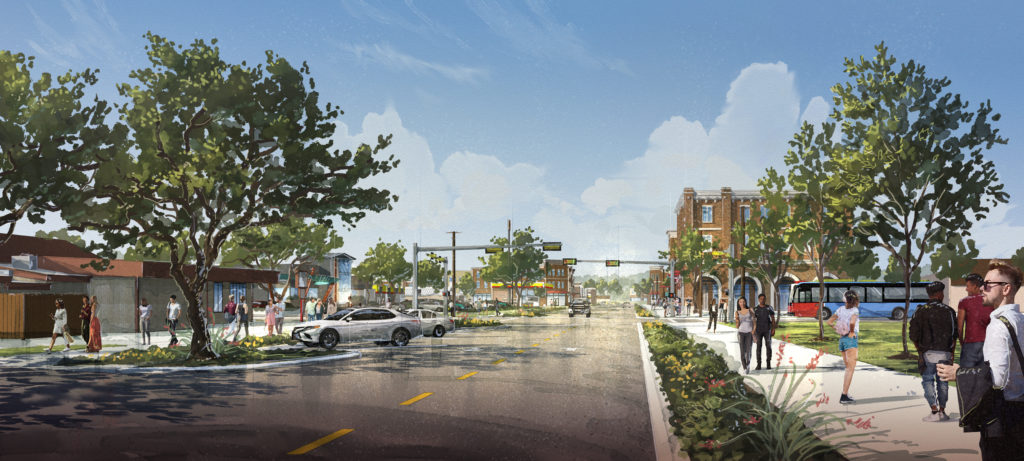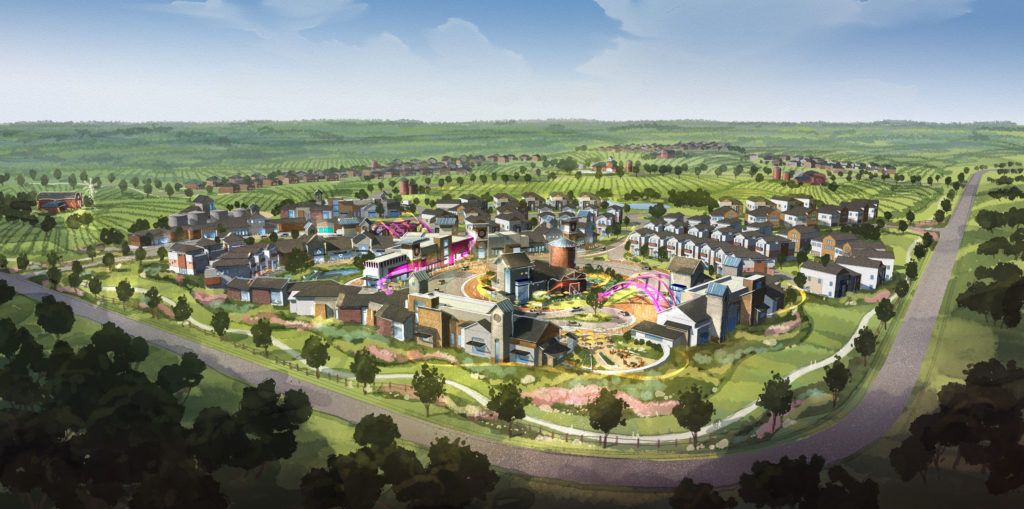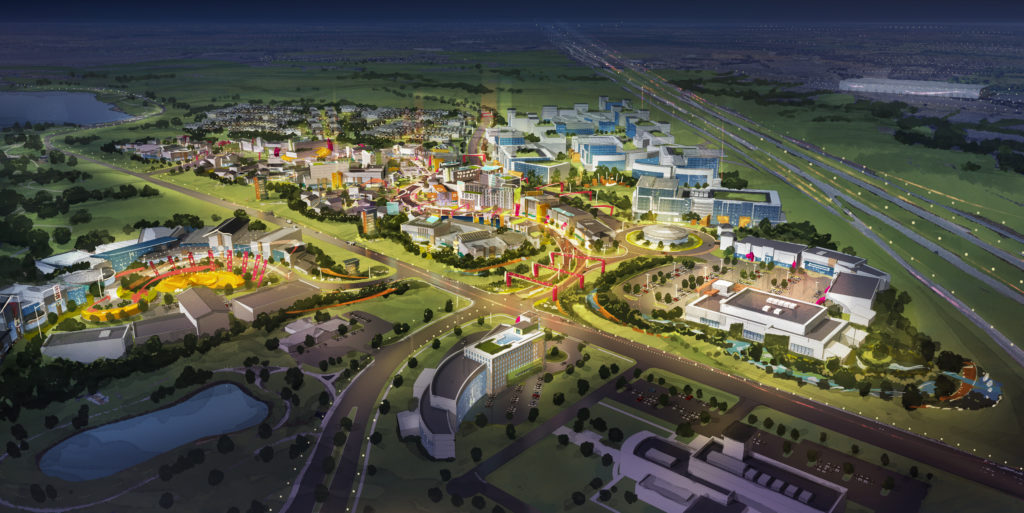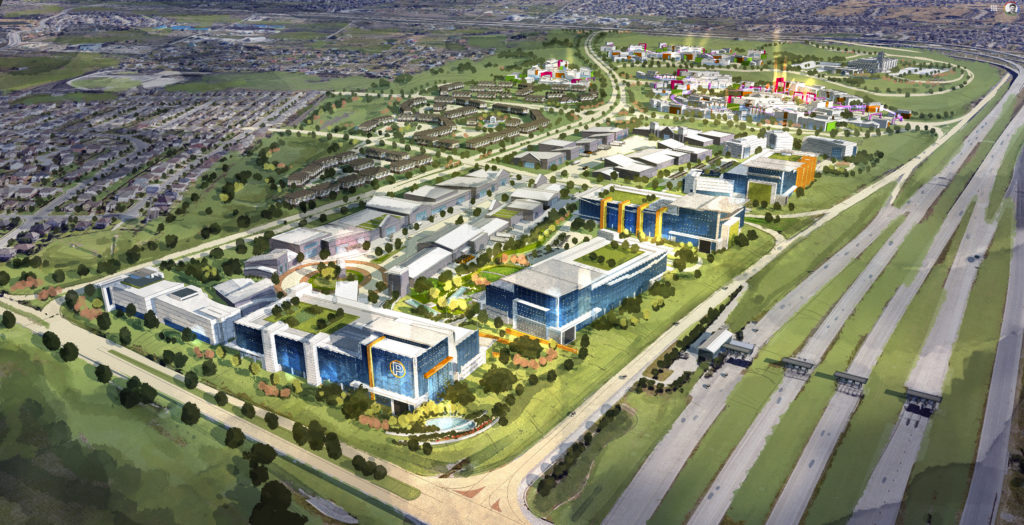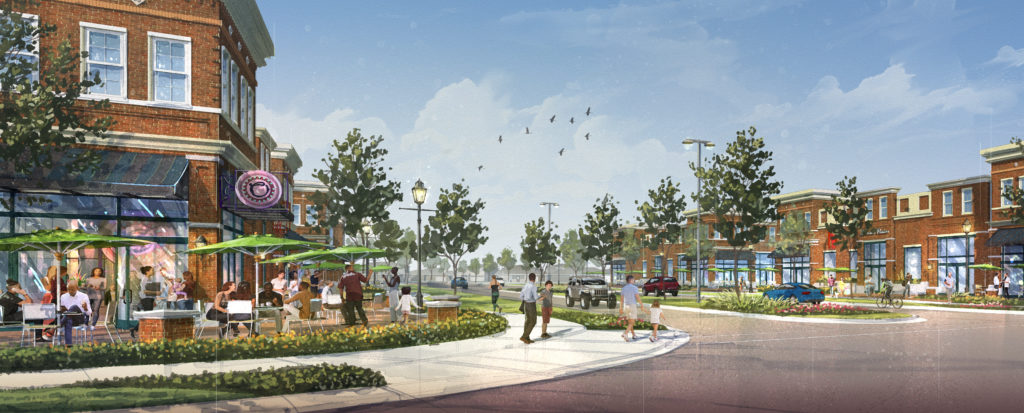Innovation: Aspire Pflugerville 2040 Plan
The Aspire 2040 Plan is a trailblazer and model for creative community engagement, a healthy community and it is an APA Texas Comprehensive Planning Award winner. It represents an unconventional means of incorporating health and wellness, including a unique Wellness Wheel as the cornerstone, and is truly a people-centered plan. It highlights the value of a holistic planning approach by incorporating City departments, functions, and services not typically represented within a comprehensive plan. This Plan began in the midst of a pandemic, challenging the team to find new ways to creatively engage residents where they felt most comfortable, which led to a higher rate of feedback and community engagement relative to traditional means.
The Plan established a “10-minute neighborhood” goal and divided the City and ETJ into Neighborhood Districts, thus providing a means of measuring community health and wellness on a geographic basis. Accounting for current levels of health and wellness will allow the City to better understand where enhancements may be implemented.
As Pflugerville continues to experience growth, establishing financial resilience is essential. The Plan’s fiscal resiliency model and analysis will ensure that Pflugerville is economically well-positioned in order to ensure it is a healthy community and able to provide excellent public services for current and future residents.
The Aspire 2040 Plan embodies Pflugerville’s unique pflavor, pfun personality, community identity, and value system through presentation and methodology, thus building and maintaining long-term support for effectiveness and implementation.
Originality and Innovation
The Aspire 2040 Plan represents a visionary approach through a creative engagement process designed to gather community feedback during the pandemic, later discussed in the engagement criterion. The incorporation of guiding principles, the Wellness Wheel, 10-minute neighborhood, and furthering what it means to provide for quality of life and how healthy community elements are interconnected make the Aspire 2040 Plan ground-breaking.
The Wellness Wheel is much more than a lofty goal; it is the foundation of personal health and well-being of Pflugerville residents, visitors, and employees as further expressed through facility planning, provision of public services, neighborhood planning, and the respective goals, objectives, and action items provided within the Plan. Similar to wellness wheels for personal growth and well-being, Pflugerville strives to create a healthy community and a high quality of life, both in the built environment and for its residents. The Wellness Wheel supports the notion that individuals should have a healthy balance of these elements to achieve high quality of life.
The Wellness Wheel is also a representation of what it means to create a complete and healthy neighborhood. While concepts of wellness contemplated by the Wellness Wheel are commonly associated with facility design and public services, geographic variability also plays a significant role in the ability of individual persons to achieve the points of wellness. Therefore, the Plan established a district-based approach to initiate steps toward achieving more complete neighborhoods. The districts were created based on physical and perceived barriers to accessing elements of a “10-minute neighborhood” and defined the connections needed to achieve a healthy community. The application and implementation of the Wellness Wheel through other plan elements, including facility planning and public services, are later discussed in other criteria.
Quality
The Aspire 2040 Plan is visually appealing with infographics and imagery to communicate more effectively with a broad audience. The Aspire 2040 Plan includes artistic renderings of areas within the City that are prime for development or redevelopment in order to communicate the vision and desirable development form more effectively. The various ways in which the Plan is shared make it truly accessible.
The Aspire Pflugerville 2040 Wellness Wheel is the foundation of facility planning and public service goals, objectives, and action items within the Plan. Furthering the Wellness Wheel goal, the Plan identifies a robust list of department-based goals and objectives for facility planning and public services. The Aspire 2040 Plan showcases the importance of public services, programming, and events provided by Parks & Recreation, Library, PAWS, and the Police Department.
Strong civic engagement and a sense of community are critical elements in creating a healthy and vibrant community. Therefore, using the framework of the Wellness Wheel and other best management practices for facility design, the Plan provides a public facility design matrix (Plan pgs. 205-206, Figure 7.7) reflected with five key design principles and four key types of civic engagement: 1.) Resident-to-Resident, 2.) Resident-to-Elected, 3.) Resident-to-Staff, and 4.) Resident-to-Story. The design of buildings can contribute to or degrade the effectiveness of city services in meeting the needs of residents, visitors, and City employees. Fortunately, the design matrix will be implemented over the next couple of years, with the innovative development of a new City Hall and Recreation Center in the Downtown East mixed-use project.
Engagement
This Plan is unique in the sense that it was entirely created during the COVID-19 pandemic, and the limitation of in-person engagement became a silver lining where increased virtual engagement options provided the City with significantly more community participation rates, data points, and survey responses, that would have not otherwise been achieved through in-person events. Through the engagement process, the City had a total of 1,623 survey responses, 2,825 video views, 1,937 open/unprompted comments, 6,543 in-person exposure at events, and 41,964 data points via virtual engagement.
Public engagement was primarily provided through virtual platforms; however, the City implemented a couple of outdoor, socially-distanced participation opportunities for those who preferred to participate through in-person engagement. Public input and information were gathered through community meetings, stakeholder meetings, City boards and commission meetings, community surveys, and several meetings with the Comprehensive Plan Advisory Committee (CPAC). The CPAC members were instrumental in getting the Aspire 2040 Plan across the finish line, with four members participating in the presentation to City Council for Plan adoption. There were also six stakeholder groups, including local business, economic and real estate, education and community, community service, neighborhood representatives, and the Youth Advisory Council (YAC), that participated in the planning process.
In addition, the City actively promoted the planning process using technology and digital platforms such as social media outlets (e.g., Facebook, Instagram, Twitter, Nextdoor and YouTube), email notifications, website updates, mailed utility bill flyers, and weekly e-newsletters. The City utilized social media for other creative means of public engagement. For example, the City encouraged Pflugerville residents to write virtual love letters to future Pflugerville in year 2040. Other fun engagement opportunities included an Oodles of Doodles chalk event organized by the City’s YAC and Aspire-themed coloring pages and programming promoted through the Pflugerville Public Library.
Implementation and Effectiveness
The foundation of the Plan and the support of the Plan process helped to set the stage to begin moving swiftly towards implementation. While the Aspire 2040 Plan was recently adopted in April 2022, the City has maintained and built momentum and public support by immediately tackling major implementation items identified within the Plan, including an SH45 small area plan, code amendments, Downtown Streetscape Master Plan, site and facility planning for a new City Hall and Recreation Center in Downtown East, a Parks, Recreation, and Open Space Master Plan, special purpose district policies, and updates to the Library’s five-year plan, all of which are anticipated to be completed over the next 12 months.
Over the past ten years, Pflugerville has experienced tremendous growth similar to other Central Texas cities and had a 51% increase in population from 2010-2020. With such growth in a relatively short timeframe and the statutory limitations for growth management and municipal finance, the City has faced significant fiscal resiliency challenges across many systems and functions, including land use management, provision of utility services across extensive land area with varying degrees of development and density, and increased need public services and facilities. The Plan’s fiscal resiliency model and financial analysis will be the foundation for long-term decision-making regarding land use and economic development.
The Wellness Wheel is likely the most significant and effective tool in making a difference in lives of Pflugerville residents through City services. With increased housing costs and living expenses, the City can offset these challenges by offering more public services that contribute to high quality of life, thus being an equalizing force and combating “growing pains.” Furthermore, unlike physical development in the community, the City can be much more agile in offering more public services, providing for a more immediate effect.
Promotion of Planning
The Aspire Plan was developed as a truly collaborative effort from all City departments, including Planning & Development Services, Communications, Parks & Recreation, Library, Police, Pflugerville Animal Welfare Services (PAWS), Public Works, CIP Engineering, and the City Manager’s Office.
Throughout the planning process for the Aspire 2040 Plan, the City made a concerted effort to inform and educate the public, stakeholders, boards and commissions, and elected officials on the value and purpose of a comprehensive plan. The City’s boards and commissions, including the Planning & Zoning Commission, Parks and Recreation Commission, Library Board, and the Equity Commission were included from the forefront. This is reflected in the result of our Aspire 2040 webpage generating over 9,000 page views, more than four times the amount of traffic in the past two years than the previous 2030 Plan webpage.
At the beginning of the project, we were encouraged by the amount of participation and enthusiasm of all City departments, not just Planning, which resulted in better representation of city departments typically not embodied in a comprehensive plan. After explaining the purpose and benefits of being represented in the Plan, they were completely on board, especially after hearing that the Plan is also a budgeting tool. (i.e., They can just point to an action item during budget season and request support funding.) This Plan resulted in the individual city departments, as well as boards and commissions, being more unified in communicating and furthering the quality of life actions articulated in the Plan.
We believe the Plan achieved a much higher level of success through the planning process because of the variety of internal and external stakeholders we brought to the table.
